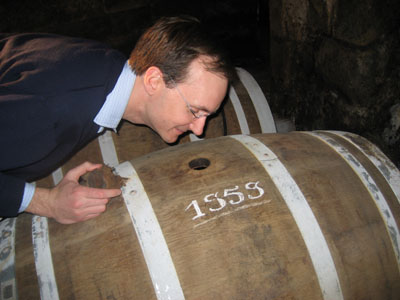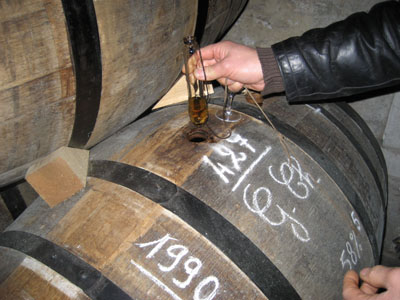Cognac in the barrel and in the cellar

Wine, how young it is. Although winemakers follow different protocols, two years is generally a safe bet for how long wine stays in a barrel. For cognac, that’s just warming up.
Since cognac hits the barrel out of the alembic somewhere between 65 – 72 percent alcohol, it can withstand the tannins of oak longer. Much longer. Although each cognac house follows different norms, the official rules on barrel aging different grades are:
VS = a blend with at least two years in the barrel
VSOP = a blend with at least four years in the barrel
XO = a blend with at least six years in the barrel
Beyond that, it’s up to the individual producers. Many age portions of their XO for more than three times as long as the minimum. And almost all have something older (and more expensive) than XO calling it “extra” or some sort of proprietary name.
The wood for the barrels can only come from France according to law. The two main sources of the oak are the Limousin and Troncais forests, each with its own character. Oak from the Limousin is wider grain, which gives more “woody” character to the resulting cognac. The barrels are also larger than wine barrels often rolling in at 350 liters versus 225L for wine.
Cognac hits its peak in the barrel at about 55 years. After that, the consensus among cellar masters that I spoke with was that it starts to decline in quality.
Each year some of the alcohol and some of the water in the barrel evaporate in a euphemism that is delightfully known as the “angels’ share.” Wine, in barrels, also evaporates. But because cognac is such a higher alcoholic strength than wine, I’d venture to say the angels in cognac cellars are a lot happier. And with a loss of something like 2.5 percent a year to vapors, that’s the equivalent of about 3 million bottles of cognac. The accountants in the region must not like to think about that kind of money literally going up in fumes.
The angels have to compete with another life form: a black mold known locally as “mushrooms” that permeates all of the cellars. Driving around the town of Cognac and the region, it is easy to pick out the buildings that are (or were) cellars since the inescapable black mold, which thrives on the alcohol vapors, clings to the high walls and roofs. One cellar master told me that the Nazis even used aerial photography during the War to identify the cognac cellars from above.
Most of the cellars in the region are semi-permeable membranes to the outside world. Some cellars that I went in had windows, others had cracks to the outside. As a result, the temperatures inside the cellars often reflect the outside, although in a less extreme way (more on how this affects taste soon). When I was there last week, temperatures were around freezing but the cellars were about 45 degrees. In the summer, they can even go higher than 70. Local cellar conditions can vary as some underground storage areas have less temperature fluctuation and higher humidity. But the angels are happy whatever the conditions.
Stay tuned for the next step in aging the oldest and rarest cognacs.
 Related: “Barrel sample, cognac style”
Related: “Barrel sample, cognac style”
 tags: cognac | barrel aging
tags: cognac | barrel aging




On February 1st, 2007 at 7:01 pm ,Victoria wrote:
Wow, I just learned a lot about Cognac… I am not a big Cognac drinker, I usually stick to wine… But very interesting never the less. Looking forward to the next article on the subject.
Cheers!
On May 30th, 2011 at 5:22 pm ,Alexandre wrote:
Victoria and others who want to find out more about Cognac. There is a great section on the cognac expert blog called “What is Cognac”.
http://blog.cognac-expert.com/what-is-cognac/